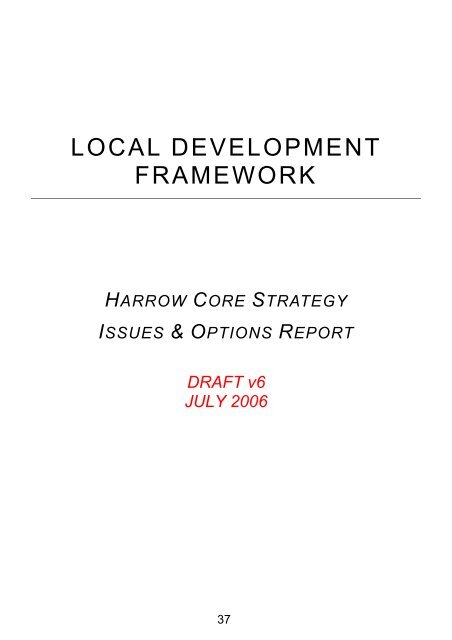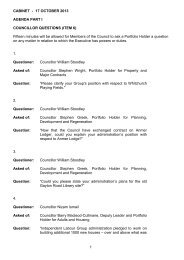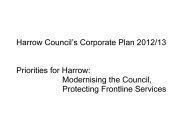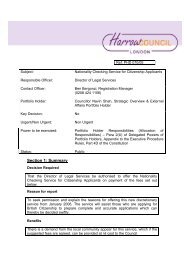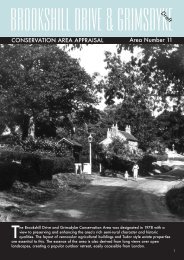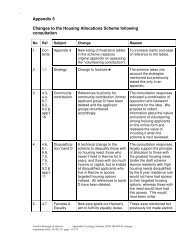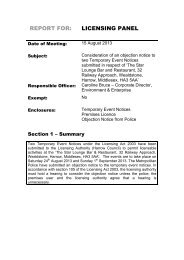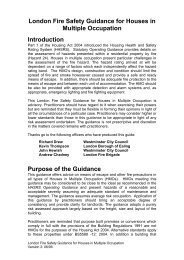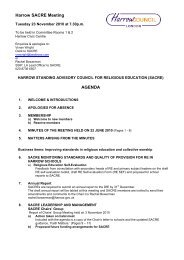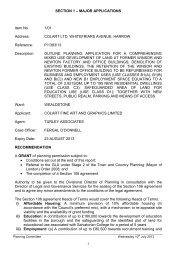LOCAL DEVELOPMENT FRAMEWORK - Harrow Council
LOCAL DEVELOPMENT FRAMEWORK - Harrow Council
LOCAL DEVELOPMENT FRAMEWORK - Harrow Council
- No tags were found...
You also want an ePaper? Increase the reach of your titles
YUMPU automatically turns print PDFs into web optimized ePapers that Google loves.
<strong>LOCAL</strong> <strong>DEVELOPMENT</strong><strong>FRAMEWORK</strong>HARROW CORE STRATEGYISSUES & OPTIONS REPORTDRAFT v6JULY 200637
CONTENTS1.0 INTRODUCTION & BACKGROUND Page 12.0 CONSULTATION ALREADY UNDERTAKEN Page 53.0 HARROW IN CONTEXT Page 64.0 A VISION AND KEY OBJECTIVES FOR THE HARROW CORE STRATEGY Page 135.0 A LOCATIONAL STRATEGY FOR HARROW Page 156.0 ISSUES AND OPTIONS – THEMATIC POLICY AREAS Page 21A1APPENDIX 1 – KEY MESSAGES FROMPRELIMINARY COMMUNITY WORKSHOPSPage 44A2 APPENDIX 2 - HARROW COMMUNITY STRATEGY OVERVIEW Page46LIST OF FIGURESFIGURE 1 PROCESS FOR PREPARING THE HARROW CORE STRATEGY PageFIGURE 2 EXISTING CONDITIONS IN HARROW PageFIGURE 3 POPULATION PROJECTIONS 2001 – 2026 PageFIGURE 4 HOUSHOLD PROJECTION 2001 – 2026 PageFIGURE 5 POPULATION DENSITY IN HARROW PageFIGURE 6 HOUSING COMPLETIONS PageFIGURE 7 WASTE PRODUCED AND RECYCLED PageFIGURE 8 RETAIL VACANCY IN HARROW’S TOWN CENTRES PageFIGURE 9 EMPLOYMENT IN HARROW BY SECTOR PageFIGURE 10 MODE OF TRAVEL TO WORK FOR PEOPLE IN HARROW PageFIGURE11 MULTIPLE DEPRIVATION IN HARROW PageFIGURE 12 PUBLIC TRANSPORT ACCESSIBILITY LEVELS IN HARROW PageFIGURE 13 KEY LOCATIONS IN HARROW PageFIGURE 14 EXISTING VIEWS AND LANDMARKS PageFIGURE 15 THE HISTORIC ENVIRONMENT IN HARROW PageFIGURE 16 OPEN SPACE IN HARROW PageFIGURE 17 ENVIRONMENTAL ASSETS Page39
1.0 INTRODUCTION AND BACKGROUND1.1 THE HARROW CORE STRATEGYThe <strong>Council</strong> has started to prepare the <strong>Harrow</strong> Core Strategy. This will set out wherechange and development will take place in <strong>Harrow</strong> and how it should be managed overthe next 15 - 20 years. The key aim of the <strong>Harrow</strong> Core Strategy is to maximise andenhance the good things about <strong>Harrow</strong> whilst addressing the things which the communitywant to see changed or improved. The <strong>Harrow</strong> Core Strategy will also be the mostimportant planning document the <strong>Council</strong> prepares as all other planning documents willneed to be consistent with it.1.2 THE HARROW <strong>LOCAL</strong> <strong>DEVELOPMENT</strong> <strong>FRAMEWORK</strong>The <strong>Harrow</strong> Local Development Framework will provide the overall planning strategy for<strong>Harrow</strong>. It will be made up of a number of separate but inter-related documents, with the<strong>Harrow</strong> Core Strategy being one of the documents. More information can be found on the<strong>Council</strong>’s website (www.harrow.gov.uk) and in the <strong>Council</strong> publication ‘A Guide to the<strong>Harrow</strong> Local Development Framework’. This gives a full overview of recent changes tothe planning system and how the <strong>Harrow</strong> Local Development Framework will bedeveloped. Details on where to obtain this publication are included within this report.1.3 HARROW CORE STRATEGY ISSUES AND OPTIONS REPORTIn order to give full effect to the <strong>Harrow</strong> Core Strategy as a basis for the <strong>Council</strong> to makeplanning decisions, it must be prepared according to a set process (which is defined bylaw). This Issues and Options Report forms a part of the set process and has beenprepared as an early stage of community involvement on what matters should becontained in the <strong>Harrow</strong> Core Strategy. It contains issues, ideas and possible options forthe types of policies and proposals which should be contained in the <strong>Harrow</strong> CoreStrategy.The Issues and Options Report is structured as follows:-• Section 2 provides an overview of what community involvement has been undertakenso far.• Section 3 provides a brief overview of the borough and some of the most importantfacts which will influence the <strong>Harrow</strong> Core Strategy.• Section 4 introduces the need for a vision and a series of objectives to set a cleardirection for the <strong>Harrow</strong> Core Strategy. Community involvement in developing thesewill be vital and a series of questions is asked to gather ideas from the community.• Section 5 outlines some of the key drivers of change which will impact on wheredevelopment will be directed to in <strong>Harrow</strong>. This is followed by a review of some of thekey geographical locations in <strong>Harrow</strong> and their potential to accommodate change.• Section 6 presents possible options for addressing the key issues facing the borough.This section is structured along thematic lines (e.g. design, housing) and introducesome initial ideas for what directions and policies should be contained in the <strong>Harrow</strong>Core Strategy.- 1 -40
1.4 WHAT IS THE ROLE OF THE COMMUNITY AND STAKEHOLDERS?Before the <strong>Council</strong> decides which ideas and options should be taken forward as <strong>Council</strong>policy, the community have the opportunity to tell the <strong>Council</strong> what it thinks and what itwants for the future of <strong>Harrow</strong>. The <strong>Council</strong> is seeking the community’s views andopinions on the range of issues and options presented, as well as other ideas andproposals which they would like the <strong>Council</strong> to consider.In particular, the <strong>Council</strong> will be asking the community and stakeholders to address thefollowing questions:-• Has the <strong>Council</strong> correctly identified the range of issues which the <strong>Harrow</strong> CoreStrategy should be trying to address?• What do you think of the options presented?• What improvements could be made to the options?• What option(s) are your preferred options that you want the <strong>Council</strong> to take forward?• Are there any options the <strong>Council</strong> hasn’t considered that you would like to beconsidered before identifying the preferred option(s)?In thinking about the options presented, it must be remembered that the preferred optionmay not be a single discreet option as presented but rather may be a combination of arange of options taking the best parts of each. Further, some of the options available arelimited by National Planning Policies and the London Plan. The Issues and Options Reportidentifies where this is the case.1.5 HOW TO COMMENT ON THE ISSUES AND OPTIONSTo help make responding to this report easier, a series of questions are asked throughoutthe document and the community is encouraged to respond to these questions andprovide the <strong>Council</strong> with its views. A response to every question is not necessary, andthose who may have an interest in only some areas can respond only to the questions ofinterest to them or their organisation. A standard form has been prepared to assist inrecording responses and the community and stakeholders are encouraged to use thisstandard form.If you would like to comment on the Issues and Options Report you can: -• Send written comments to:-LDF ConsultationPolicy and Research<strong>Harrow</strong> <strong>Council</strong> - Garden House5 St Johns Road<strong>Harrow</strong> HA1 2EE• E-mail your comments to: @harrow.gov.uk- 2 -41
The consultation period for the Issues and Options Report ends on Friday 13 October2006. It is important that all those in the community who wish to provide the <strong>Council</strong> withtheir views do so before this date. This is to ensure the <strong>Council</strong> has plenty of time toconsider what everyone has said and to move forward to the next stage (i.e. preferredoptions).1.6 OTHER DOCUMENTSThe <strong>Council</strong> is also making available for community involvement two other documents.Firstly, the Site Specific Proposals Issues and Options Report has been prepared. Thissets out issues and possible options for the future use of key development sites in <strong>Harrow</strong>.This will be an important document that will form part of the <strong>Harrow</strong> Local DevelopmentFramework.Secondly, the <strong>Council</strong> has made available the Sustainability Appraisal Scoping Report forpublic viewing. This document sets out a substantial amount of data and information whichwill be used to help determine the best options to be taken forward in the <strong>Harrow</strong> CoreStrategy.The inside back cover of this report contains details on where to obtain these publications.1.7 NATIONAL PLANNING POLICY AND THE LONDON PLANNational Planning Policy, contained in a series of statements, guidance notes andcirculars, identifies Government planning policies. There is a legal requirement that the<strong>Harrow</strong> Core Strategy be consistent with National Planning Policy. This means that therange of choices available to the <strong>Council</strong> are sometimes limited by Government policy.Where this is the case, this report highlights this fact so that the community is able to takethis into account when responding to the issues and options.Further, the London Plan is the planning strategy of the Mayor of London. There is a legalrequirement that the <strong>Harrow</strong> Core Strategy be in general conformity with the London Plan.This requirement impacts on the flexibility and choices open to the <strong>Council</strong> in dealing withsome issues and where this is the case it has been highlighted in this report.1.8 WHAT HAPPENS NEXT?Once the <strong>Council</strong> has reviewed what the community have said during the formalconsultation period which ends on 13 October 2006, it will consider what should be thepreferred options for the <strong>Harrow</strong> Core Strategy. The <strong>Council</strong> will then consult again withthe community on the preferred options. This consultation will take place in mid 2007.Anyone who provides the <strong>Council</strong> with comments in response to the Issues and OptionsReport will automatically be re-consulted on the preferred options.The figure below outlines all the stages that the <strong>Council</strong> will go through as it prepares the<strong>Harrow</strong> Core Strategy.- 3 -42
FIGURE 1 – PROCESS FOR PREPARING THE HARROW CORE STRATEGYRESEARCH AND EVIDENCE GATHERINGCONSULTATION ON THE ISSUES AND OPTIONSCurrent StageCONSULTATION ON THE PREFERRED OPTIONSSUBMIT DOCUMENT TO SECRETARY OF STATEFOR EXAMINATION ANDFURTHER CONSULTIATIONINDEPENDENT EXAMINATIONADOPTION- 4 -43
3.0 HARROW IN CONTEXTThis section provides a brief overview of some key information about <strong>Harrow</strong>. Thepurpose of reviewing the current situation in <strong>Harrow</strong> is to ensure that the <strong>Harrow</strong> CoreStrategy responds to the key issues facing the borough. A full exploration of the currentsituation (baseline) in <strong>Harrow</strong> can be found in the following documents:-• Annual Monitoring Report (2005);• Sustainability Appraisal Scoping Report (2006);• <strong>Harrow</strong> Vitality Profiles (2004).All of these documents can be obtained from the <strong>Council</strong> (see the inside back cover of thisreport for details).3.1 LOCATION OF HARROW AND KEY FEATURES<strong>Harrow</strong> is an Outer London Borough, situated in North-West London and approximatelyten miles from Central London. The Borough is part of the West London sub-region, whichcomprises five other London Boroughs: Ealing, Brent, Hammersmith & Fulham, Hillingdonand Hounslow. The London Borough of Barnet borders the eastern part of the Boroughand Hertfordshire lies to the north of <strong>Harrow</strong>, with the District <strong>Council</strong>s of Three Rivers andHertsmere immediately adjoining.FIGURE 1 - HARROW IN THE REGIONAL CONTEXT- 6 -45
<strong>Harrow</strong> is 50 square kilometres (19 square miles) in area and is a predominantly dormitoryresidential suburban area, with a relatively small amount of land and buildings devoted toemployment and industrial activity when compared with other Outer London boroughs.Over a quarter of the Borough (over 1,300 hectares) is open space, which helps make<strong>Harrow</strong> one of London's most attractive suburban areas in London. The Borough is wellserved by both mainline rail and underground services. Four underground lines traversethe Borough - the Metropolitan, Jubilee, Bakerloo and Piccadilly lines with stationssituated across the Borough. Mainline rail services are provided by the Chiltern Railways,Silverlink and Southern Railways, with services to Central London, Northampton,Birmingham, Gatwick, Watford and Aylesbury. The major road network which links to theM1, M25 and M40 motorways.3.2 POPULATION AND HOUSINGWith a population of 211,900 (2004), <strong>Harrow</strong> is the 22 nd largest borough in terms ofpopulation in London. The population is expected to continue to grow steadily in comingyears. 14.5% of <strong>Harrow</strong>’s population is aged 65 or over. This is higher than the GreaterLondon average of 12.4%. The population is aging, meaning that the proportion of peoplein the 65 or over range is expected to rise over coming years.In the 2001 Census <strong>Harrow</strong> was rated as the fifth highest borough in England and Walesin terms of the proportion of the population from an ethnic minority (42%).FIGURE 3 – POPULATION PROJECTIONS 2001 – 2026Population222,000220,000218,000216,000214,000212,000210,000208,000206,000204,0002001 2006 2011 2016 2021 2026Year(Source – 2005 Interim Round of GLA Demographic Projections (Scenario 8.07), GLA, October 2005)With changing demography, and particularly a trend towards smaller households, there isprojected to be a significant rise in the number of households in the Borough.- 7 -46
FIGURE 4 – HOUSEHOLD PROJECTIONS 2001 - 2026(Source – 2005 Interim Round of GLA Demographic Projections (Scenario 8.07), GLA, October 2005)The following map gives an indication of the distribution of population density in theBorough.FIGURE 5 – POPULATION DENSITY IN HARROW(Source – 2001 Census. Crown copyright)- 8 -47
The table below indicates that the amount of housing being built in the Borough has beenvery high in recent years. The percentage of affordable housing 1 has been dependent toa large extent on the planning policy situation, which has varied throughout the time periodshown in the table.FIGURE 6 – HOUSING COMPELTIONS IN HARROWPeriodNet Number of unitscompletedNet number ofaffordable unitsbuiltPercentageAffordableApril 2000 – March 2001 155 -3 -1.9%April 2001 – March 2002 375 57 15.2%April 2002 – March 2003 373 96 25.7%April 2003 – March 2004 553 110 19.9%April 2004 – March 2005 497 89 17.9%(Source – <strong>Harrow</strong> <strong>Council</strong> Annual Monitoring Report, 2005)3.4 WASTEHousehold waste has risen over recent years although there are indications that this trendmay be changing with a reduced total in the last financial year. Recycling levels are alsorising.FIGURE 7 – WASTE PRODUCED AND RECYCLEDYearTotal Household Waste(tonnes) Proportion Recycled (%) Including Compost2000/2001 88321 10.62001/2002 90491 9.42002/2003 95662 9.42003/2004 98115 13 13.20%2004/2005 105331 12.8 18.50%2005/2006 98808 13.8 26.7%(Note - figures for compost only available from 2003/04)(Source – <strong>Harrow</strong> <strong>Council</strong> Annual Monitoring Report, 2005)3.5 RETAIL AND TOWN CENTRES<strong>Harrow</strong> Town Centre is the 10th largest town centre in London. The following table showsthe vacancy rates of total measured retail frontage in <strong>Harrow</strong>’s town centres.1 Affordable housing is defined in the <strong>Harrow</strong> Unitary Development Plan as ‘housing that meets the needs ofhouseholds whose incomes are not sufficient to allow them to access decent and appropriate housing’.- 9 -48
FIGURE 8 – RETAIL VACANCY IN HARROW’S TOWN CENTRES3.6 EMPLOYMENT% FrontageVacant<strong>Harrow</strong> Town Centre 4.56Burnt Oak 9.55Edgware 3.75Kingsbury 0North <strong>Harrow</strong> 10.5Pinner 2.59Rayners Lane 6.15South <strong>Harrow</strong> 0.9Stanmore 2.23Wealdstone 13.72Belmont 7.13<strong>Harrow</strong> Weald 3.83Hatch End 2.52Kenton 6.62Queensbury 7.59Sudbury Hill 0.56Average Vacancy Rate = 5.14(Source – <strong>Harrow</strong> <strong>Council</strong> Annual Monitoring Report, 2005)In August 2005 3.1% of <strong>Harrow</strong>’s residents were unemployed. This rate is equal to therate for England, however is lower than that for Inner and Outer London. The followingchart describes the break-up of employment types by sector in the Borough.FIGURE 9 – MIX OF EMPLOYMENT IN HARROW BY SECTOR- 10 -49(Source – <strong>Harrow</strong> <strong>Council</strong> Annual Monitoring Report, 2005)
3.7 TRANSPORTOver three-quarters of households in <strong>Harrow</strong> use a car or van, which is the secondhighest level in London. Road traffic has increased steadily in the ten years up to 2002,although it then dropped in 2003. Nearly 58% of residents work within the Borough. In2001 51% of people travelled to work by car or van.FIGURE 10 – MODE OF TRAVEL TO WORK FOR PEOPLE IN HARROW - 1991 & 2001 COMPARISON3.8 INDEX OF MULTIPLE DEPRIVATION(Source – <strong>Harrow</strong> <strong>Council</strong> Annual Monitoring Report, 2005)Multiple Deprivation is an indicator developed by the Government. It is a basket ofindicators comprising income, employment, health & disability, education skills & training,housing and services, living environment, and crime. It is useful as an overall indication ofthe level of deprivation in the Borough and the spatial variation of this.Multiple deprivation in <strong>Harrow</strong> is well below the national average, with <strong>Harrow</strong> ranking232nd out of 354 districts in England, 29th out of 33 London boroughs, and 15th out of 19Outer London boroughs, where 1st is the most deprived. Just 2 of <strong>Harrow</strong>’s 137 areas (inPinner and Roxbourne) are in England’s most deprived 20%, and 38 (mostly in thewestern part of the borough) in the country’s 20% least deprived.- 11 -50
FIGURE 11 – MULTIPLE DEPRIVATION IN HARROW(Source - ODPM, Indices of Deprivation 2004)- 12 -51
4.0 A VISION AND KEY OBJECTIVESFOR THE HARROW CORE STRATEGY4.1 VISIONThe <strong>Harrow</strong> Community Strategy (2004) contained the following vision for <strong>Harrow</strong>:-‘A borough that is safe, clean, healthy and prosperous, with equal lifeopportunities for all – a friendly and vibrant place to be.’This vision was developed by the<strong>Harrow</strong> Strategic Partnership bylistening to partners, residents andstakeholders in <strong>Harrow</strong>. The LocalDevelopment Framework, and the<strong>Harrow</strong> Core Strategy in particular, willneed to take forward this vision andadvance it through the planningsystem, whether it be by the decisionsthe <strong>Council</strong> makes on planningapplications or through the actions ofthe community.Appendix 1 provides a brief overview ofthe <strong>Harrow</strong> Community Strategy andthe <strong>Harrow</strong> Strategic Partnership.Question 1What ways do you think the above vision for <strong>Harrow</strong> can be advancedthrough the <strong>Harrow</strong> Core Strategy?4.2 OBJECTIVESA series of initial objectives have been developed which seek to provide directions forwhat the <strong>Harrow</strong> Core Strategy should be trying to achieve. These have been drawn froma review of National and regional planning policy, a review of the full range of <strong>Council</strong> andpartner strategies, and from the evidence base which will underpin the <strong>Harrow</strong> CoreStrategy.1. To create a more sustainable <strong>Harrow</strong> in terms of the use of resources, the distributionof land uses, the transport system, and the design and construction of newdevelopment.2. To support a vibrant and balanced local economy, which provides a range ofemployment opportunities for all and which supports small, medium and largeenterprises in <strong>Harrow</strong>.3. To maintain and enhance the vitality and viability of the <strong>Harrow</strong>’s town centres.4. To meet the housing needs of the <strong>Harrow</strong> community, including the need for affordablehousing.- 13 -52
5. To ensure that all parts of the built and natural environment is accessible for all in thecommunity.6. To protect and enhance the natural environment, including the green belt, and to make<strong>Harrow</strong> a greener borough.7. To create a healthy borough and to improve opportunities for all in the community toreach their full potential.8. To create a safer <strong>Harrow</strong>.Question 2What do you think of the draft objectives for the <strong>Harrow</strong> Core Strategy? Arethere other matters you want included or that you think the <strong>Council</strong> shouldbe trying to achieve?- 14 -53
5.0 A LOCATIONAL STRATEGY FOR HARROWA key element of the <strong>Harrow</strong> Core Strategy will be identifying broad locations in theborough that will be a focus for new development and where change will be expected.Change can take many forms, including locations needing regeneration, locations for newhousing, locations for new community facilities like schools and open space, and evenlocations like conservation areas where change can be encouraged to better protect andimprove the special character of an area.The <strong>Harrow</strong> Core Strategy will need to clearly identify the key locations for newdevelopment and change, the type of changes which the <strong>Council</strong> is seeking to encourageand promote, and the way in which the <strong>Council</strong>, key stakeholders, and the community aregoing to manage change (e.g. implementation and delivery).This section of the Issues and Options Report highlights some of the main influences thatneed to be considered in determining the strategy for where new development andchange should be focused. It also highlights key locations in the borough and theirpotential to accommodate change.5.1 MAIN INFLUENCES IN DETERMINING LOCATIONS FOR CHANGE IN HARROW5.1.1 NEED TO ACCOMMODATE NEW HOUSINGAND THE DENSITY OF NEW HOUSING<strong>Harrow</strong> is largely a residential area, with the majority of the housing stock being detachedand semi detached housing. Large dwellings tend to be in the north of the Borough whilstthe central and southern areas are more urban with a higher density of development. Wehave recently seen a considerable amount of new house building activity. These havepredominately been flat developments which has helped to broaden the types of housingwithin the area and providing for a greater level of housing choice.In order to meet part of the demand for housing, the London Plan (2004) sets a target of330 additional dwellings per year in <strong>Harrow</strong> between 1997 and 2016. To meet this targetwe have been developing housing on sites in the existing urban area and increasingdensities (the intensity of development). This has helped to achieve our target over therecent past. Proposed changes to the London Plan are expected to result in revisions tothe housing target, with an increase to 400 additional dwellings per year for the period2007/8 – 2016/17. This must be factored into the <strong>Harrow</strong> Core Strategy.The ability to provide for a range of housing choices in accessible locations will continue topresent challenges. There is strong demand for new and different types of housing as thepopulation continues to grow and change. However our ability to deliver new housing isconstrained by lack of available land for development and also the need to protectvaluable countryside and open space. Expensive housing costs and limited supply ofsocial housing also limits the housing choices available particularly for those on lowincomes.Question 3Question 4Where should the <strong>Council</strong> be focusing new housing in <strong>Harrow</strong>?Are there locations in <strong>Harrow</strong> where the <strong>Council</strong> should be encouraginghigher densities for new housing development?The locations outlined in Section 5.2 and areas with good public transport identifiedin Figure 13 may be helpful in thinking about and responding to these questions.- 15 -54
5.1.2 INTEGRATING <strong>DEVELOPMENT</strong> AND TRANSPORTThe integration of transport and development will be an important part of planning for thefuture of <strong>Harrow</strong>. Patterns of development which reduce the need to travel (especially bycar) and which locate high trip generating activities in locations with high levels of publictransport access are considered to be more sustainable ways of planning for newdevelopment. This is reflected also in National Planning Policy and in the London Plan.Figure 12 identifies the areas in <strong>Harrow</strong> with good public transport accessibility.Question 5Question 6How should the <strong>Council</strong> be promoting more sustainable forms of travel (e.g.more walking, cycling, and public transport use)?What types of development should be located in areas with good publictransport?FIGURE 12 – PUBLIC TRANSPORT ACCESSIBILITY LEVELS IN HARROW- 16 -55
5.1.3 HIGH BUILDINGSHigh buildings are generally defined as buildings which are significantly taller than theirsurroundings and/or buildings which will have a significant impact on the skyline. TheLondon Plan recognizes that tall buildings can be a very efficient way of using land andcan make an important contribution to the overall attractiveness of the urban environment.The <strong>Council</strong>’s existing policy on high buildings requires that any development whichproposes a tall building should: -• Be of outstanding architectural quality;• Be able to secure a complete and well designed setting, including hard and softlandscaping, so that the development interacts with, and contributes positively to, itssurroundings at street level;• Be set in the context of an urban design analysis, including the impact on local,medium and long distance views and places;• Emphasise or contribute to a point of civic or visual significance (including a cluster) ora centre of urban activity or regeneration, both locally and in relation to the immediatearea and the wider area from which it will be visible;• Achieve a positive relationship with topographical features and other buildings nearby,and contribute to the image and built environment of London; and enhance the skylineby ensuring that the roof top design is of high quality.One of the key matters which the <strong>Harrow</strong> Core Strategy will need to identify is anylocations which may be suitable for tall buildings.Question 7Should the <strong>Council</strong> be encouraging tall buildings in <strong>Harrow</strong> and if so,where?The locations outlined in Section 5.2 may be helpful in thinking about andresponding to this question.5.1.4 PROTECTING EMPLOYMENT LAND IN HARROWIn recent years there has been limited new development on employment land and strongmarket pressure to redevelop the land for other uses such as housing. Traditionally the<strong>Council</strong> has sought to retain important existing employment sites and premises bysafeguarding them from other uses. This aim was to provide for a range of land uses inthe Borough and to maintain a level of employment land for business and industrial uses.Government policy and the London Plan require that employment land be reviewed inorder to identify surplus sites that could be redeveloped for other uses, particularlyhousing. Due to a decline in the manufacturing sector it is projected that at a London widelevel there will be significant amounts of land available for other uses. However, it isimportant that decisions about the release of employment land are based on firm evidenceas once employment land is lost to other uses its potential to generate and retain jobs islost forever.The <strong>Council</strong> is undertaking an Employment Land Study which will help inform decisions onthe extent and location of employment land that should be retained for employmentpurposes.- 17 -56
Question 8Question 9Question 10Should the <strong>Council</strong> retain all land that is currently designated for industrialand business use to ensure there is a defined supply of land for futureindustry, warehousing and offices to meet need?Under what circumstances should the <strong>Council</strong> allow the release ofemployment land?Do you think it would be satisfactory to allow the release of employmentland to mixed-use developments where the same level of industrial,warehousing and office floorspace is provided as part of the newdevelopment?Figure 13 identifies the broad locations of land currently designated foremployment uses. More exact details can be seen on the <strong>Harrow</strong> UnitaryDevelopment Plan Proposals Map.5.2 KEY LOCATIONS IN HARROW5.2.1 HARROW TOWN CENTRE<strong>Harrow</strong> Town Centre is a metropolitan centre and is the tenth largest in London. Thecentre contains over 300 retail and service stores equating to 110,000 square metres ofretail floorspace. Shopping is the primary attraction, however, there are also a range ofoffice and residential developments as well as leisure activities.There is potential for <strong>Harrow</strong> Town Centre to grow to accommodate a range of uses. It isanticipated that there will continue to be strong demand for retail space in <strong>Harrow</strong>,particularly larger retail stores. Housing developments are also likely to take advantage ofthe accessible location. New housing could form part of mixed use developments or theconversion of existing office space (where appropriate). There are already a number ofmixed use developments planned and there is potential for additional developments whichcould assist in promoting a more vibrant town centre.Question 11Question 12Question 13Question 14How should the <strong>Council</strong> transform <strong>Harrow</strong> Town Centre into a thriving anddistinctive centre that meets the need of the local community?Should the <strong>Council</strong> promote a wider range of uses in <strong>Harrow</strong> Town Centreand if so, what should they be?What kind of leisure activities would assist in promoting a more vibrant nightlife in <strong>Harrow</strong> Town Centre?What improvements should the <strong>Council</strong> make to <strong>Harrow</strong> Town Centre?5.2.2 DISTRICT TOWN CENTRESThere are nine district town centres in (or partially in) the borough – Wealdstone, South<strong>Harrow</strong>, Rayners Lane, North <strong>Harrow</strong>, Pinner, Stanmore, Edgware, Burnt Oak andKingsbury. These centres play an important role by providing a range of services andactivities that are not generally available at a local level. In recent years there has notbeen a great deal of new activity and developments in these centres. However there maybe potential for the centres to accommodate new retail and leisure uses and also othertypes of uses.Question 15Question 16Question 17How should the <strong>Council</strong> promote district town centres in <strong>Harrow</strong> andincrease their usage?What other uses should be promoted in district town centres?What changes would you like to see to any of the district town centres in<strong>Harrow</strong>?- 18 -57
Question 18Is there potential to intensify activity in any district centres? Are there arange of uses that could be encouraged to promote speciality centres?5.2.3 AREAS AROUND TOWN CENTRESThere are 16 town centres in <strong>Harrow</strong> ranging from the metropolitan centre of <strong>Harrow</strong> tolocal centres in Hatch End and Sudbury Hill. The residential areas surrounding thesetown centres present opportunities for intensifying developments, as these are generallymore accessible by public transport and located closer to the services available in towncentres. A greater intensity of development in the surrounding areas could also assist inthe supporting the town centres.Question 19Do you think areas immediately around town centres have the potential toaccommodate new development owing to their close proximity to the publictransport and facilities in town centres?5.2.5 RESIDENTIAL AREAS IN HARROWWithin the residential areas of <strong>Harrow</strong> there is potential to accommodate new housingdevelopments through small-scale infill, subdivision of large plots and the conversions oflarger houses into smaller dwellings. For some areas new housing developments presentopportunities to improve the quality of the urban environment by replacing poor housingstock with well designed and sited housing. In other areas that are not in need ofregeneration new housing developments can be accommodated while protecting theimportant characteristics of the area.Question 19Question 20Question 21What residential areas in <strong>Harrow</strong> could benefit from new housingdevelopments?What facilities should be provided before new housing is permitted to takeplace?What aspects of the residential areas in <strong>Harrow</strong> need to be preserved andwhat aspects should be changed or improved to make the borough a betterplaces to live?- 19 -58
FIGURE 13 – KEY LOCATIONS IN HARROW- 20 -59
6.0 ISSUES AND OPTIONS – THEMATIC POLICY AREASThis section outlines issues and options for the <strong>Harrow</strong> Core Strategy across a range ofthematic policy areas. For each policy area, the following information is presented: -Key IssuesStrategicDirectionsOptionsThe key issues have been derived from a review of the evidence base,national planning policy, the London Plan, the <strong>Council</strong>’s strategies andthe strategies of key stakeholders, as well as the consultationundertaken to date.A brief strategic direction is presented in order to provide a context forthe development of options. Views on these directions, and how theycan be further developed or improved, will be important in establishinga very clear basis for the <strong>Harrow</strong> Core Strategy to be further developedin subsequent stages of its preparation.Possible options, in a very preliminary form, are presented. Thesecover a wide range of possibilities but none should be seen torepresent, at this stage, the formal position of the <strong>Council</strong>. The purposeof presented options is to outline the range and type of matters whichwill be considered.It is important to note that only some policy areas involve a choicebetween discrete ways forward (options). Other policy areas contain arange of possibilities which may all be relevant when deciding on thepreferred ways forward. There may also be other options notmentioned which the community want the <strong>Council</strong> to consider.EvidenceBasePolicyDesignationsThe <strong>Council</strong> knows that many organisations in the community haveinformation that might be of assistance to deciding what the best wayforward is. This section is intended to draw out of the community anyinformation which they think would be useful in developing the <strong>Harrow</strong>Core Strategy.Many policies which will be contained in the <strong>Harrow</strong> Core Strategy willapply to a specific part(s) of the borough (e.g. town centres). As such,a policy designation will need to be made on the Proposals Map whichwill accompany the <strong>Harrow</strong> Core Strategy.The existing <strong>Harrow</strong> Unitary Development Plan Proposals Map will bethe started pointing for where these designations could be applied, withvariations made as a result of the development of the <strong>Harrow</strong> CoreStrategy.Throughout this section a range of generic questions have been asked which seek togather the views of the community and key stakeholders on the various policy areas. Aspreviously mentioned, a response to every question is not necessary and those who mayhave an interest in only some matters can respond only to the questions of interest tothem or their organisation.- 21 -60


